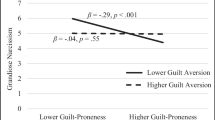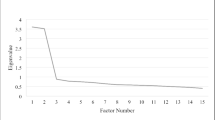Abstract
There is much evidence that primary psychopathy is related to a deficit in emotion processing. The question remains, however, as to whether a deficit in self-conscious emotions hinders the ability to infer expected self-conscious emotions in others. Relying on an indirect testing of emotion attribution, we explored the possibility that primary psychopathy would predict difficulty in distinguishing between shame and guilt. Results showed that participants scoring high in primary psychopathy had more difficulties (i.e., they were less accurate) differentiating between guilt eliciting and shame eliciting events. The findings held even when controlling for age and gender. The importance of self-conscious emotions proneness when attributing emotions to others and implications for future research are discussed.

Similar content being viewed by others
References
Aharoni, E., Sinnott-Armstrong, W., & Kiehl, K. A. (2012). Can psychopathic offenders discern moral wrongs? A new look at the moral/conventional distinction. Journal of Abnormal Psychology, 121(2), 484.
Barrett, K. C. (1995). A functionalist approach to shame and guilt. In J. P. Tangney & K. W. Fischer (Eds.), The self-conscious emotions: The psychology of shame, guilt, embarrassment, and pride (pp. 25–63). New York: Guilford Press.
Baumeister, R. F., Stillwell, A. M., & Heatherton, T. F. (1995). Personal narratives about guilt: Role in action control and interpersonal relationships. Basic and Applied Social Psychology, 17(1–2), 173–198.
Beer, J. S., Heerey, E. A., Keltner, D., Scabini, D., & Knight, R. T. (2003). The regulatory function of self-conscious emotion: Insights from patients with orbitofrontal damage. Journal of Personality and Social Psychology, 85(4), 594.
Benedict, R. (1967). The chrysanthemum and the sword: Patterns of japanese culture. New York: Houghton Mifflin Harcourt.
Blackburn, R. (1998). Psychopathy and personality disorder: Implications of interpersonal theory. NATO ASI Series D Behavioural and Social Sciences, 88, 269-302.
Blair, R. (1995). A cognitive developmental approach to morality: Investigating the psychopath. Cognition, 57, 1–29.
Blair, R., & Cipolotti, L. (2000). Impaired social response reversal. Brain, 123(6), 1122–1141.
Blair, R., Sellars, C., Strickland, I., Clark, F., Williams, A., Smith, M., & Jones, L. (1995). Emotion attributions in the psychopath. Personality and Individual Differences, 19(4), 431–437.
Blair, R., Colledge, E., Murray, L., & Mitchell, D. (2001). A selective impairment in the processing of sad and fearful expressions in children with psychopathic tendencies. Journal of Abnormal Child Psychology, 29(6), 491–498.
Campbell, J. S., & Elison, J. (2005). Shame coping styles and psychopathic personality traits. Journal of Personality Assessment, 84(1), 96–104.
Cima, M., Tonnaer, F., & Hauser, M. D. (2010). Psychopaths know right from wrong but don’t care. Social Cognitive and Affective Neuroscience, 5(1), 59–67.
Cleckley, H. C. (1976). The mask of sanity. St. Louis, MO: Mosby.
Combs, D. J., Campbell, G., Jackson, M., & Smith, R. H. (2010). Exploring the consequences of humiliating a moral transgressor. Basic and Applied Social Psychology, 32(2), 128–143.
Else-Quest, N. M., Higgins, A., Allison, C., & Morton, L. C. (2012). Gender differences in self-conscious emotional experience: A meta-analysis. Washington, DC: American Psychological Association.
Fergus, T. A., Valentiner, D. P., McGrath, P. B., & Jencius, S. (2010). Shame-and guilt-proneness: Relationships with anxiety disorder symptoms in a clinical sample. Journal of Anxiety Disorders, 24(8), 811–815.
Ferguson, T. J., & Crowley, S. L. (1997). Gender differences in the organization of guilt and shame. Sex Roles, 37(1–2), 19–44.
Ferguson, T. J., Eyre, H. L., & Ashbaker, M. (2000). Unwanted identities: A key variable in shame–anger links and gender differences in shame. Sex Roles, 42(3–4), 133–157.
Giammarco, E. A., & Vernon, P. A. (2015). Interpersonal guilt and the dark triad. Personality and Individual Differences, 81, 96–101.
Gilbert, P., & McGuire, M. (1998). Shame, social roles and status: The psychobiological continuum from monkey to human. In P.Gilbert & B. Andrews (Eds.),Shame: Interpersonal behavior,psychopathology and culture (pp. 99–125). New York: Oxford University Press.
Harvey, O. J., Gore, E. J., Frank, H., & Batres, A. R. (1997). Relationship of shame and guilt to gender and parenting practices. Personality and Individual Differences, 23(1), 135-146
van Honk, J., & Schutter, D. J. (2006). Unmasking feigned sanity: A neurobiological model of emotion processing in primary psychopathy. Cognitive Neuropsychiatry, 11(3), 285–306.
Hornak, J., Rolls, E., & Wade, D. (1996). Face and voice expression identification in patients with emotional and behavioural changes following ventral frontal lobe damage. Neuropsychologia, 34(4), 247–261.
Johnson, R. C., Danko, G. P., Huang, Y.-H., Park, J. Y., Johnson, S. B., & Nagoshi, C. T. (1987). Guilt, shame, and adjustment in three cultures. Personality and Individual Differences, 8(3), 357–364.
Jonason, P. K., & Krause, L. (2013). The emotional deficits associated with the dark triad traits: Cognitive empathy, affective empathy, and alexithymia. Personality and Individual Differences, 55(5), 532–537.
Levenson, M. R., Kiehl, K. A., & Fitzpatrick, C. M. (1995). Assessing psychopathic attributes in a noninstitutionalized population. Journal of Personality and Social Psychology, 68(1), 151.
Lewis, H. (1971). Shame and guilt in neurosis (1st ed.). New York: International University Press.
Lickel, B., Schmader, T., Curtis, M., Scarnier, M., & Ames, D. R. (2005). Vicarious shame and guilt. Group Processes & Intergroup Relations, 8(2), 145–157.
Lyons, M. T. (2015). Evidence for an evolutionary cheater strategy relationships between primary and secondary psychopathy, parenting, and shame and guilt. The Journal of Psychology, 149(6), 570–581.
McHoskey, J. W., Worzel, W., & Szyarto, C. (1998). Machiavellianism and psychopathy. Journal of Personality and Social Psychology, 74(1), 192.
Miller, J. D., Gaughan, E. T., & Pryor, L. R. (2008). The levenson self-report psychopathy scale an examination of the personality traits and disorders associated with the lsrp factors. Assessment, 15(4), 450–463.
Morrison, D., & Gilbert, P. (2001). Social rank, shame and anger in primary and secondary psychopaths. The Journal of Forensic Psychiatry, 12(2), 330–356.
O’Boyle Jr., E. H., Forsyth, D. R., Banks, G. C., & McDaniel, M. A. (2012). A meta-analysis of the dark triad and work behavior: A social exchange perspective. Journal of Applied Psychology, 97(3), 557.
Orth, U., Berking, M., & Burkhardt, S. (2006). Self-conscious emotions and depression: Rumination explains why shame but not guilt is maladaptive. Personality and Social Psychology Bulletin, 32(12), 1608–1619.
Patrick, C. J. (2005). Handbook of psychopathy. New York: Guilford Press.
Polaschek, D. L. (2014). Adult criminals with psychopathy: Common beliefs about treatability and change have little empirical support. Current Directions in Psychological Science, 23(4), 296–301.
Prado, C. E., Treeby, M. S., & Crowe, S. F. (2015). Examining relationships between facial emotion recognition, self-control, and psychopathic traits in a non-clinical sample. Personality and Individual Differences, 80, 22–27.
Prado, C. E., Treeby, M. S., & Crowe, S. F. (2016). Examining the relationships between sub-clinical psychopathic traits with shame, guilt and externalisation response tendencies to everyday transgressions. The Journal of Forensic Psychiatry & Psychology, 27(4), 569–585.
Shafran, R., Watkins, E., & Charman, T. (1996). Guilt in obsessive-compulsive disorder. Journal of Anxiety Disorders, 10(6), 509–516.
Smith, R. H., Webster, J. M., Parrott, W. G., & Eyre, H. L. (2002). The role of public exposure in moral and nonmoral shame and guilt. Journal of Personality and Social Psychology, 83(1), 138.
Tangney, J. P. (1992). Situational detenninants of shame and guilt in young adulthood. Personality and Social Psychology Bulletin, 18(2), 199–206.
Tangney, J. P. (1996). Conceptual and methodological issues in the assessment of shame and guilt. Behaviour Research and Therapy, 34(9), 741–754.
Tangney, J. P., & Dearing, R. L. (2003). Shame and guilt. New York: Guilford Press.
Tangney, J. P., Wagner, P., & Gramzow, R. (1992). Proneness to shame, proneness to guilt, and psychopathology. Journal of Abnormal Psychology, 101(3), 469.
Tangney, J. P., Miller, R. S., Flicker, L., & Barlow, D. H. (1996). Are shame, guilt, and embarrassment distinct emotions? Journal of Personality and Social Psychology, 70(6), 1256.
Tangney, J. P., Stuewig, J., & Mashek, D. J. (2007). Moral emotions and moral behavior. Annual Review of Psychology, 58, 345–372.
Tracy, J. L., & Robins, R. W. (2004). Putting the self into self-conscious emotions: A theoretical model. Psychological Inquiry, 15(2), 103–125.
Tracy, J. L., Robins, R. W., & Tangney, J. P. (2007). The self-conscious emotions: Theory and research. New York: Guilford Press.
Author information
Authors and Affiliations
Corresponding authors
Ethics declarations
Conflict of Interests
Hakim Djeriouat declares that he has no conflict of interest in the conduct and the reporting of the research. Bastien Trémolière declares that he has no conflict of interest in the conduct and the reporting of the research.
Ethical Approval
The conduct of this study was approved by the scientific and ethical board of the CLLE LTC. “All procedures performed in the study involving human participants were in accordance with the ethical standards of the institutional and/or national research committee and with the 1964 Helsinki declaration and its later amendments or comparable ethical standards”.
Informed Consent
Informed consent was obtained from all participants included in the study. The data reported in the present manuscript has not been previously published or simultaneously submitted elsewhere.
Electronic supplementary material
ESM 1
(DOCX 9 kb)
Rights and permissions
About this article
Cite this article
Djeriouat, H., Trémolière, B. Shame and Guilt Situational Identification in Subclinical Primary Psychopaths. Curr Psychol 39, 238–245 (2020). https://doi.org/10.1007/s12144-017-9756-8
Published:
Issue Date:
DOI: https://doi.org/10.1007/s12144-017-9756-8




